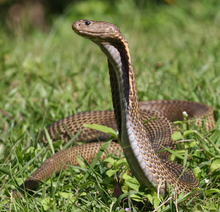Philippine cobra
| Philippine cobra | |
|---|---|

| |
| Scientific classification | |
| Domain: | Eukaryota |
| Kingdom: | Animalia |
| Phylum: | Chordata |
| Class: | Reptilia |
| Order: | Squamata |
| Suborder: | Serpentes |
| Family: | Elapidae |
| Genus: | Naja Laurenti, 1768 |
| Species: | N. philippinensis
|
| Binomial name | |
| Naja philippinensis | |

| |
| Distribution of the Philippine cobra | |
The Philippine cobra (Naja philippinensis) also called Philippine spitting cobra or northern Philippine cobra, is a stocky, highly venomous species of spitting cobra native to the northern regions of the Philippines. The Philippine cobra is called ulupong in Tagalog, carasaen in Ilocano.
Taxonomy
Naja philippinensis was described by American herpetologist Edward Harrison Taylor in 1922. The generic name naja is a Latinisation of the Sanskrit word nāgá (नाग) meaning "cobra". The specific epithet philippinensis is Latin and literally means "from the Philippine Islands".[3]
Description
The Philippine cobra is a stocky snake of medium length with long cervical ribs capable of expanding, so when threatened, a hood can be formed. The average length of this species is 1.0 metre (3.3 ft).
This snake has the ability to spit but seldom does so, often choosing to biting and striking instead when threatened.
Scalation
There are 23-27 (usually 25) scale rows around neck, 21 (rarely 23) just ahead of mid-body; 182-193 ventrals, 36-49 subcaudals, basal pairs sometimes undivided.[7]
Distribution and habitat
The Philippine cobra occurs mostly in the northern regions of the
The Philippine cobra's habitat include low-lying plains and forested regions,[4] along with open fields, grasslands, dense jungle, agricultural fields, and human settlements. This species of cobra is particularly fond of water, so it can be found very close to ponds, rivers, or large puddles of water.[4][9]
Diet
This species feeds predominantly on small mammals, frogs, and even other snakes.
Predators
Predators of this species include humans,
Venom
Although venom toxicity values can vary greatly even among specimens of the same species, the Philippine cobra is considered to possess one of the more toxic venoms among the Naja (cobra) species. According to Tan et al., the
The
References
- ^ a b "Naja philippinensis". The IUCN Red List of Threatened Species. www.iucn.org. Retrieved 7 January 2012.
- ^ "Appendices | CITES". cites.org. Retrieved 2022-01-14.
- ^ a b "Naja philippinensis Taylor, 1922". The Reptile Database. reptile-database.org. Retrieved 7 January 2012.
- ^ a b c d e f g "Naja philippinensis". Clinical Toxinology Resource. The University of Adelaide. Retrieved 1 December 2011.
- ^ a b c Lutz, M. 2006. Die Kobras des philippinischen Archipels, Teil I: Die Philippinen-Kobra, Naja philippinensis Taylor 1922. Sauria 28 (3): 5-11
- ^ a b Wüster, Wolfgang (1993). "A century of confusion: Asiatic cobras revisited" (PDF). Vivarium. 4 (4): 14–18. Retrieved 1 December 2011.
- ^ "Bangor University Open Days".
- PMID 8735239. Retrieved 1 December 2011.
- ^ a b Wüster, W. & R.S. Thorpe (1990) Systematics and biogeography of the Asiatic cobra (Naja naja) species complex in the Philippine Islands. In G. Peters & R. Hutterer (Eds.), Vertebrates in the Tropics: 333-344. Museum A. Koenig, Bonn (Naja naja) species complex in the Philippine Islands
- PMID 27022154.
- ^ Salafranca, ES (1972). "Venom yields of the Philippine cobra, Naja naja philippinensis" (PDF). Zoologica. 57 (3): 127–134. Retrieved 7 November 2022.
- ^ PMID 3177741.
- ^ Envenomation and Treatment
External links
- U.S. Naval Medical Research
- Naja philippinensis
- "Naja philippinensis - Mario Lutz`s HerpaWorld Institute"
- "Wolfgang Wüster's - Asiatic Cobra Page"
- Lutz, M. (2006) Die Kobras des philippinischen Archipels - Teil I: Die Philippinen-Kobra, Naja philippinensis Taylor, 1922, Sauria, Berlin, 28 (3): 31-37

